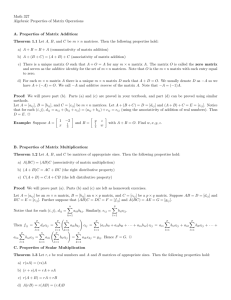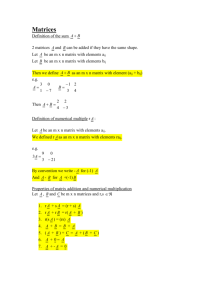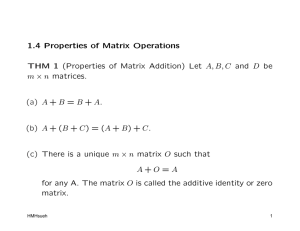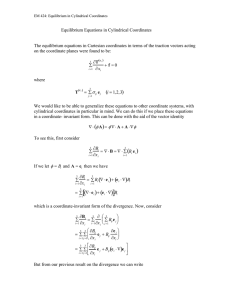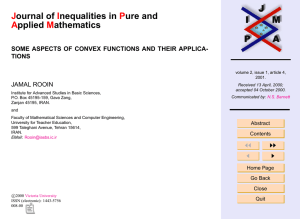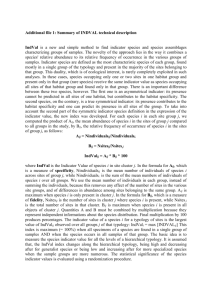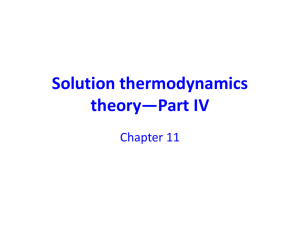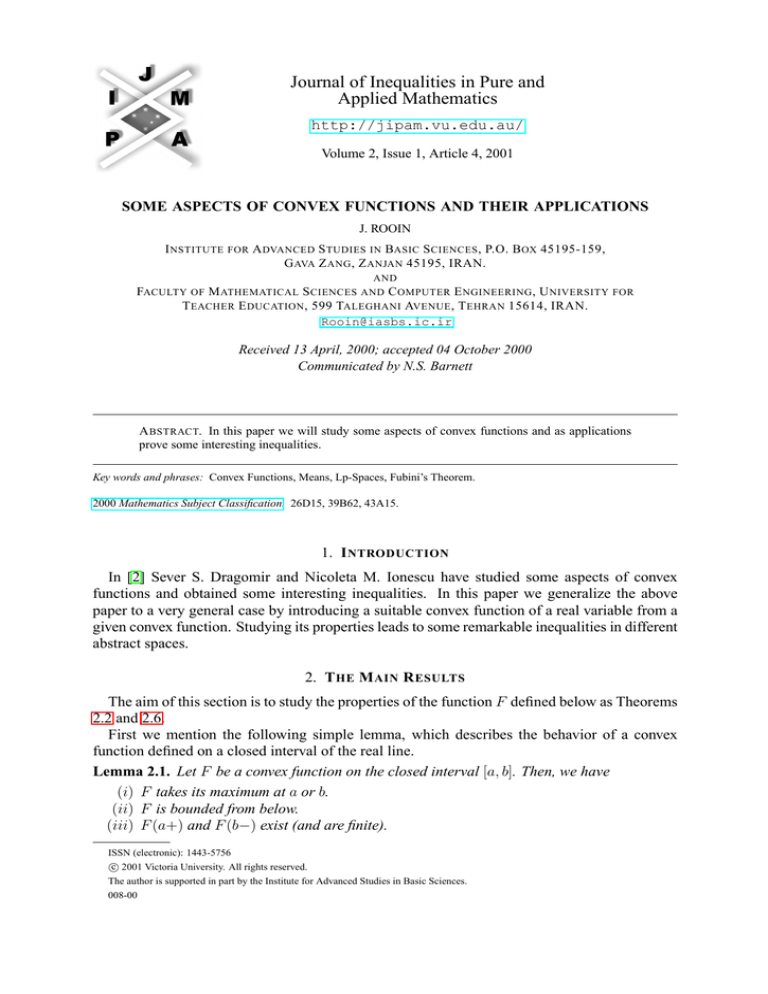
Journal of Inequalities in Pure and
Applied Mathematics
http://jipam.vu.edu.au/
Volume 2, Issue 1, Article 4, 2001
SOME ASPECTS OF CONVEX FUNCTIONS AND THEIR APPLICATIONS
J. ROOIN
I NSTITUTE FOR A DVANCED S TUDIES IN BASIC S CIENCES , P.O. B OX 45195-159,
G AVA Z ANG , Z ANJAN 45195, IRAN.
AND
FACULTY OF M ATHEMATICAL S CIENCES AND C OMPUTER E NGINEERING , U NIVERSITY FOR
T EACHER E DUCATION , 599 TALEGHANI AVENUE , T EHRAN 15614, IRAN.
Rooin@iasbs.ic.ir
Received 13 April, 2000; accepted 04 October 2000
Communicated by N.S. Barnett
A BSTRACT. In this paper we will study some aspects of convex functions and as applications
prove some interesting inequalities.
Key words and phrases: Convex Functions, Means, Lp-Spaces, Fubini’s Theorem.
2000 Mathematics Subject Classification. 26D15, 39B62, 43A15.
1. I NTRODUCTION
In [2] Sever S. Dragomir and Nicoleta M. Ionescu have studied some aspects of convex
functions and obtained some interesting inequalities. In this paper we generalize the above
paper to a very general case by introducing a suitable convex function of a real variable from a
given convex function. Studying its properties leads to some remarkable inequalities in different
abstract spaces.
2. T HE M AIN R ESULTS
The aim of this section is to study the properties of the function F defined below as Theorems
2.2 and 2.6.
First we mention the following simple lemma, which describes the behavior of a convex
function defined on a closed interval of the real line.
Lemma 2.1. Let F be a convex function on the closed interval [a, b]. Then, we have
(i) F takes its maximum at a or b.
(ii) F is bounded from below.
(iii) F (a+) and F (b−) exist (and are finite).
ISSN (electronic): 1443-5756
c 2001 Victoria University. All rights reserved.
The author is supported in part by the Institute for Advanced Studies in Basic Sciences.
008-00
2
J. ROOIN
(iv) If the infimum of F over [a, b] is less than F (a+) and F (b−), then F takes its minimum
at a point x0 in (a, b).
(v) If a ≤ x0 < b (or a < x0 ≤ b), and F (x0 +) (or (F (x0 −)) is the infimum of F over
[a, b], then F is monotone decreasing on [a, x0 ] (or [a, x0 )) and monotone increasing on
(x0 , b] (or [x0 , b]).
Proof. See [3, 4].
Definition 2.1. Let X be a linear space, and f : C ⊆ X → R be a convex mapping on a convex
subset C of X. For n given elements x1 , x2 , · · · , xn of C, we define the following mapping of
real variable F : [0, 1] → R by
X n
n
P
f
aij (t)xj
j=1
F (t) = i=1
,
n
where aij : [0, 1] → R+ (i, j = 1, · · · , n) are affine mappings, i.e., aij (αt1 + βt2 ) = αaij (t1 ) +
βaij (t2 ) for all α, β ≥ 0 with α + β = 1 and t1 , t2 in [0, 1], and for each i and j
n
X
aij (t) = 1,
i=1
n
X
aij (t) = 1 (0 ≤ t ≤ 1).
j=1
The next theorem contains some remarkable properties of this mapping.
Theorem 2.2. With the above assumptions, we have:
x1 + · · · + xn
f (x1 ) + · · · + f (xn )
(i) f
≤ F (t) ≤
(0 ≤ t ≤ 1).
n
n
(ii) F is convex on [0, 1].
R1
x1 + · · · + xn
f (x1 ) + · · · + f (xn )
≤ 0 F (t)dt ≤
.
(iii) f
n
n
P
(iv) Let pi ≥ 0 with Pn = ni=1 pi > 0, and ti are in [0, 1] for all i = 1, 2, · · · , n. Then, we
have the inequality:
!
n
x1 + · · · + xn
1 X
(2.1)
f
≤ F
pi ti
n
Pn i=1
≤
n
1 X
f (x1 ) + · · · + f (xn )
pi F (ti ) ≤
,
Pn i=1
n
which is a discrete version of Hadamard’s result.
Proof.
(i) By the convexity of f , for all 0 ≤ t ≤ 1, we have
!
Pn Pn
i=1
j=1 aij (t)xj
F (t) ≥ f
n
!
Pn Pn
j=1
i=1 aij (t)xj
= f
n
!
Pn
j=1 xj
= f
,
n
J. Inequal. Pure and Appl. Math., 2(1) Art. 4, 2001
http://jipam.vu.edu.au/
S OME A SPECTS OF C ONVEX F UNCTIONS AND T HEIR A PPLICATIONS
3
and
Pn Pn
aij (t)f (xj )
Pn Pn n
j=1
i=1 aij (t)f (xj )
=
n
Pn
j=1 f (xj )
=
.
n
(ii) Let α, β ≥ 0 with α + β = 1 and t1 , t2 be in [0, 1]. Then,
P
Pn
n
f
a
(αt
+
βt
)x
ij
1
2
j
i=1
j=1
F (αt1 + βt2 ) =
P n
Pn
Pn
n
i=1 f α
j=1 aij (t1 )xj + β
j=1 aij (t2 )xj
=
n P
P
Pn
Pn
n
n
f
a
(t
)x
f
a
(t
)x
i=1
j=1 ij 1 j
i=1
j=1 ij 2 j
≤ α
+β
n
n
= αF (t1 ) + βF (t2 ).
F (t) ≤
i=1
j=1
Thus F is convex.
(iii) F being convex on [0, 1], is integrable on [0, 1], and by (i), we get (iii).
(iv) The first and last inequalities in (2.1) are obvious from (i), and the second inequality
follows from Jensen’s inequality applied for the convex function F .
Lemma 2.3. The general form of an affine mapping g : [0, 1] → R is
g(t) = (1 − t)k0 + tk1 ,
where k0 and k1 are two arbitrary real numbers.
The proof follows by considering t = (1 − t) · 0 + t · 1.
Lemma
If aij : [0, 1] →P
R+ (i, j = 1, 2, · · · , n) are affine mappings such that for each t, i
P2.4.
and j, ni=1 aij (t) = 1 and nj=1 aij (t) = 1, then there exist nonnegative numbers bij and cij ,
such that
(2.2)
aij (t) = (1 − t)bij + tcij (0 ≤ t ≤ 1; i, j = 1, · · · , n),
and for any i and j
n
X
bij =
i=1
n
X
cij = 1, and
i=1
n
X
bij =
j=1
n
X
cij = 1.
j=1
Proof. The decomposition of (2.2) is immediate from Lemma 2.3, and the rest of the proof
comes from below:
n
X
0 ≤ aij (0) = bij , 0 ≤ aij (1) = cij ,
n
n
n
X
X
X
bij =
aij (0) = 1,
cij =
aij (1) = 1,
i=1
i=1
i=1
i=1
n
X
n
X
n
X
n
X
j=1
bij =
j=1
J. Inequal. Pure and Appl. Math., 2(1) Art. 4, 2001
aij (0) = 1,
j=1
cij =
aij (1) = 1.
j=1
http://jipam.vu.edu.au/
4
J. ROOIN
Remark 2.5. A lot of simplifications occur if we take
(2.3)
bij = δ ij and cij = δ i,n+1−j (i, j = 1, · · · , n),
in Lemma 2.4, where δ ij is the Kronecker delta.
Theorem 2.6. With the above assumptions, if bij and cij are in the form (2.3), then we have:
(i) For each t in 0, 21 , F 12 + t = F 12 − t .
(ii) max{F (t) : 0 ≤ t ≤ 1} = F (0) = F (1) = n1 (f (x1 ) + · · · + f (xn )).
P
(iii) min{F (t) : 0 ≤ t ≤ 1} = F 21 = ni=1 f xi +x2n+1−i n.
(iv) F is monotone decreasing on 0, 12 and monotone increasing on 12 , 1 .
Proof.
(2.4)
(i) Since bij = δ ij and cij = δ i,n+1−j , we have
n
P
f [(1 − t)xi + txn+1−i ]
i=1
,
F (t) =
n
and therefore, for each t in 0, 21 ,
n
P
f 12 + t xi + 12 − t xn+1−i
1
F
−t
= i=1
2
n
n
P
f 12 + t xn+1−i + 12 − t xi
= i=1
n
1
= F
+t .
2
(ii) It is obvious from (2.4), and (i) of Lemma 2.1.
(iii) If F ( 12 ) is not the minimum of F over [0, 1], then by (i), there is a 0 < t ≤ 12 , such that
1
1
1
F
−t =F
+t <F
.
2
2
2
But, using the convexity of F over [0, 1], we have
1
1
1
1
1
1
F
≤ F
−t + F
+t <F
,
2
2
2
2
2
2
a contradiction.
(iv) It is obvious from (iii) of Theorem 2.6, and (v) of Lemma 2.1.
3. A PPLICATIONS
Application 1. Let x1 , x2 , · · · , xn be n nonnegative numbers. Then, with the above notations,
we have
v
uY
n
u n X
√
x1 + x2 + · · · + xn
n
n
t
x1 x2 · · · xn ≤
[(1 − t)bij + tcij ]xj ≤
,
(3.1)
n
i=1 j=1
(3.2)
v
u n
uY
√
x1 + x2 + · · · + xn
n
n
x1 x2 · · · xn ≤ t
[(1 − t)xi + txn+1−i ] ≤
,
n
i=1
J. Inequal. Pure and Appl. Math., 2(1) Art. 4, 2001
http://jipam.vu.edu.au/
S OME A SPECTS OF C ONVEX F UNCTIONS AND T HEIR A PPLICATIONS
5
for all t in [0, 1], and
√
n
(3.3)
x1 x2 · · · xn
v
u
Pj cij xj P c x −1 P b x
u
P
( j ij j j ij j )
uY
n
u
j cij xj
n
≤ e−1 u
Pj bij xj
t P
i=1
j bij xj
x1 + x2 + · · · + xn
.
n
≤
In particular
√
n
(3.4)
v
u n xn+1−i 1
u
Y xn+1−i (xn+1−i −xi )
n
−1 t
≤ e
xxi i
i=1
x1 x2 · · · xn
≤
x1 + x2 + · · · + xn
,
n
and
√
(3.5)
x1 x2 ≤ e
2n + 2
2n + 1
(3.6)
−1
1
1+
n
xx1 1
xx2 2
1
1 −x2
x
n
r
≤e≤
≤
x1 + x2
,
2
n+1
n
1
1+
n
n
.
Proof. If we take f : (0, ∞) → R, f (x) = − ln x, then we have
n
n
X
1X
F (t) = −
ln
[(1 − t)bij + tcij ]xj
n i=1
j=1
!
,
and
Z
0
1
n
1X
F (t)dt = −
n i=1
1
Z
ln
0
n
X
!
[(1 − t)bij + tcij ]xj
Pn
1P
c x − n
b x
j=1 ij j
j=1 ij j
Pnj=1 cij xj Pn
j=1 cij xj
1 Y
= − ln
P
Pnj=1 bij xj
n i=1
n
j=1 bij xj
n
dt
j=1
+ 1,
which proves (3.1) and (3.3). In particular, if we take bij = δ ij and cij = δ i,n+1−j (i, j =
1, · · · , n), we obtain (3.2) and (3.4) from (3.1) and (3.3) respectively. The result (3.5) is immediate from (3.4). If we take x1 = n, x2 = n + 1 in (3.5), we get (3.6).
Application 2. If X is a Lebesgue measurable subset of Rk , p ≥ 1, and f1 , f2 , · · · , fn belong
to Lp = Lp (X), then we have
i
Pn hPn
Pn
p
f1 + · · · + fn i=1
j=1 cij |fj |;
j=1 bij |fj |
≤
(3.7)
n
n(p + 1)
p
kf1 kpp + · · · + kfn kpp
≤
,
n
J. Inequal. Pure and Appl. Math., 2(1) Art. 4, 2001
http://jipam.vu.edu.au/
6
J. ROOIN
and
(3.8)
Pn
f1 + · · · + fn p
i=1 [|fi | ; |fn+1−i |]
≤
n
n(p + 1)
p
kf1 kpp + · · · + kfn kpp
≤
,
n
where for each Lebesgue measurable function g ≥ 0 and h ≥ 0 on X,
p+1
Z p+1
p+1 g
g
− hp+1
−
h
=
[g; h] = dx,
g − h 1
g−h
X
when g(x) = h(x), the integrand is understood to be (p + 1)g p (x).
In particular, if p is an integer then,
p n P
P
k p−k p
fi .fn+1−i f1 + · · · + fn kf1 kpp + · · · + kfn kpp
1
≤ i=1 k=0
≤
,
(3.9)
n
n(p + 1)
n
p
and
(3.10)
f1 + f2 p
2 ≤
p
p P
k p−k f
.f
1 2 1
k=0
p+1
kf1 kpp + kf2 kpp
≤
,
2
Proof. Since
(f1 + · · · + fn ) ≤ (|f1 | + · · · + |fn |) n
n
p
p
and the Lp −norms of fi and |fi | are equal (i = 1, · · · , n), it is sufficient to assume fi ≥ 0 (i =
1, · · · , n). If we take ϕ → kϕkp for the convex function Lp → R, then using Fubini’s theorem
we get
n
p
Z 1
n Z
1 X 1
X
F (t)dt =
[(1 − t)bij + tcij ]fj dt
n i=1 0 j=1
0
p
!p
Z
Z
n
n
X
1X 1
=
[(1 − t)bij + tcij ]fj (x) dxdt
n i=1 0 X j=1
!p
n Z Z 1
n
X
1X
=
[(1 − t)bij + tcij ]fj (x) dtdx
n i=1 X 0
j=1
P
p+1 P
p+1
n
n
Z
n
−
X
j=1 cij fj
j=1 bij fj
1
Pn
Pn
dx
=
n(p + 1) i=1 X
j=1 cij fj −
j=1 bij fj
i
Pn hPn
Pn
c
f
;
b
f
i=1
j=1 ij j
j=1 ij j
=
,
n(p + 1)
which yields (3.7). In particular, if we set bij = δ ij and cij = δ i,n+1−j (i, j = 1, · · · , n), (3.8)
follows from (3.7). Finally, (3.9) and (3.10) are immediate from (3.8).
Remark 3.1. Let X be a Lebesgue measurable subset of Rk with finite measure, and M be the
vector space of all Lebesgue measurable functions on X with pointwise operations [1]. The set
J. Inequal. Pure and Appl. Math., 2(1) Art. 4, 2001
http://jipam.vu.edu.au/
S OME A SPECTS OF C ONVEX F UNCTIONS AND T HEIR A PPLICATIONS
7
C, consisting of all nonnegative measurable functions on X, is a convex subset of M. Since
t
the function t → 1+t
(t ≥ 0) is concave, the mapping ϕ : C → R with
Z
ϕ(f ) =
X
f
dx (f ∈ C)
1+f
is concave.
Application 3. With the above notations, if f1 , · · · , fn belong to M, then
n
(3.11)
1X
n i=1
Z
X
|fi |
dx
1 + |fi |
P
n Z
1 + nj=1 cij |fj |
1X
1
P
P
dx
≤ m(X) −
ln
n i=1 X nj=1 (cij − bij )|fj | 1 + nj=1 bij |fj |
Pn
Z
1
i=1 |fi |
n
P
≤
dx,
n
1
X 1+ n
i=1 |fi |
n
(3.12)
1X
n i=1
Z
X
|fi |
dx
1 + |fi |
n Z
1X
1
1 + |fn+1−i |
≤ m(X) −
ln
dx
n i=1 X |fn+1−i | − |fi |
1 + |fi |
Pn
Z
1
i=1 |fi |
n
P
≤
dx,
n
1
X 1+ n
i=1 |fi |
2
(3.13)
1X
2 i=1
Z
X
Z
|fi |
1
1 + |f2 |
dx ≤ m(X) −
ln
dx
1 + |fi |
1 + |f1 |
X |f2 | − |f1 |
P2
Z
1
i=1 |fi |
2
dx,
≤
P
2
1
|f
|
X 1+ 2
i
i=1
in which, generally, when a = b > 0, the ratio (ln b − ln a)(b − a) is understood as 1a.
Proof. We can suppose that fi ≥ 0 (1 ≤ i ≤ n). Since ϕ is concave, taking ϕ and φ instead of
f and F in Theorem 2.2 respectively, we get
Z 1
ϕ(f1 ) + · · · + ϕ(fn )
(3.14)
≤
φ(t)dt
n
0
f1 + · · · + fn
≤ ϕ
.
n
However, by Fubini’s theorem and applying the change of variables
u=
n
X
[(1 − t)bij + tcij ]fj (x),
j=1
J. Inequal. Pure and Appl. Math., 2(1) Art. 4, 2001
http://jipam.vu.edu.au/
8
J. ROOIN
in the following integrals, we have,
Pn
Z
Z 1
n Z
1X 1
j=1 [(1 − t)bij + tcij ]fj (x)
P
φ(t)dt =
dxdt
n i=1 0 X 1 + nj=1 [(1 − t)bij + tcij ]fj (x)
0
Pn
n Z Z 1
1X
j=1 [(1 − t)bij + tcij ]fj (x)
P
dtdx
=
n i=1 X 0 1 + nj=1 [(1 − t)bij + tcij ]fj (x)
Z Pnj=1 cij fj (x) n Z
1
1X
1
P
=
1−
dudx
n i=1 X nj=1 (cij − bij )fj (x) Pnj=1 bij fj (x)
1+u
P
n Z
1 + nj=1 cij fj
1
1X
P
P
= m(X) −
ln
dx,
n i=1 X nj=1 (cij − bij )fj 1 + nj=1 bij fj
and after substituting this in (3.14), we obtain (3.11). The inequalities (3.12) and (3.13) are
special cases of (3.11), taking bij = δ ij and cij = δ i,n+1−j .
Acknowledgement 1. I would like to express my gratitude to Professors A. R. Medghalchi and
B. Mehri for their valuable comments and suggestions.
R EFERENCES
[1] S. BERBERIAN, Lectures in functional analysis and operator theory, Springer, New YorkHeidelberg-Berlin, 1974.
[2] S. S. DRAGOMIR AND N. M. IONESCU, Some remarks on convex functions, Revue d’analyse
numérique et de théorie de l’approximation, 21 (1992), 31–36.
[3] A.W. ROBERTS AND D.E. VARBERG, Convex functions, Academic Press, New York and London,
1973.
[4] R. WEBSTER, Convexity, Oxford University Press, Oxford, New York, Tokyo, 1994.
J. Inequal. Pure and Appl. Math., 2(1) Art. 4, 2001
http://jipam.vu.edu.au/


